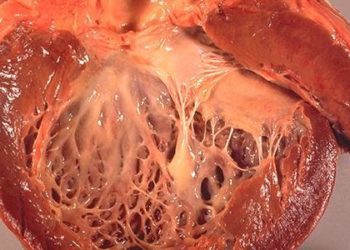Fibrosis linked with mortality in nonischemic dilated cardiomyopathy patients
[tabs tab1=”2MM Rundown” tab2= “2MM Full Report”]
[tab]
Image: PD
1. Midwall myocardial fibrosis shown to serve as independent predictor of mortality in nonischemic dilated cardiomyopathy patients.
2. Assessment of midwall myocardial fibrosis can improve the accuracy of risk assessment in these patients.
Published today in JAMA, this prospective study indicates the presence of midwall fibrosis in nonischemic dilated cardiomyopathy patients is independently associated with increased mortality and has the potential to increase the clinical risk in these patients. The current standard of care for nonischemic dilated cardiomyopathy is based on assessing left ventricular ejection fraction (LVEF). While it is a proven indicator of mortality in these patients, the use of LVEF is fraught with inconsistencies in treatment and prognosis. The authors of this study demonstrate that incorporating the assessment of midwall fibrosis could improve the accuracy of risk stratification for these patients. Midwall fibrosis was found to independently associated with increased rates of sudden cardiac death, heart failure, arrhythmia, cardiac transplantation, and device implantation.
Limitations to this study include a single institution patient population, as well as a lack of explanation for the number of incorrect risk reclassifications using the proposed schema by the authors. Nonetheless, this study provides a solid foundation for the potential clinical use of midwall fibrosis as a mortality predictor in dilated cardiomyopathy patients.
Click to read the study, published today in JAMA
[/tab]
[tab]
Image: PD
1. Midwall myocardial fibrosis shown to serve as independent predictor of mortality in nonischemic dilated cardiomyopathy patients.
2. Assessment of midwall myocardial fibrosis can improve the accuracy of risk assessment in these patients.
This [prospective, longitudinal] study: This prospective study evaluated 472 consecutive patients with dilated cardiomyopathy at the Royal Brompton Hospital in London between November 2000 and December 2008. Follow-up was accomplished via telephone calls or postal questionnaire at 6-month intervals. Overall, mortality occurred in 26.8% of midwall fibrosis patients and 10.6 % of those without midwall fibrosis. Patients with midwall fibrosis were also 5 times more likely than those without it to experience sudden cardiac death, appropriate ICD shock, nonfatal ventricular fibrillation, or sustained ventricular tachycardia (29.6% vs 7.0%, respectively). Furthermore, with the addition of midwall fibrosis to LVEF, the accuracy of the mortality risk model for dilated cardiomyopathy patients improved substantially (net reclassification improvement, 0.26; P =.001).
In sum: This prospective study indicates the presence of midwall fibrosis in nonischemic dilated cardiomyopathy patients is independently associated with increased mortality and has the potential to increase the clinical risk in these patients. The current standard of care for nonischemic dilated cardiomyopathy is based on assessing left ventricular ejection fraction (LVEF). While it is a proven indicator of mortality in these patients, the use of LVEF is fraught with inconsistencies in treatment and prognosis. The authors of this study demonstrate that incorporating the assessment of midwall fibrosis could improve the accuracy of risk stratification for these patients. Midwall fibrosis was found to independently associated with increased rates of sudden cardiac death, heart failure, arrhythmia, cardiac transplantation, and device implantation.
Limitations to this study include a single institution patient population, as well as a lack of explanation for the number of incorrect risk reclassifications using the proposed schema by the authors. Nonetheless, this study provides a solid foundation for the potential clinical use of midwall fibrosis as a mortality predictor in dilated cardiomyopathy patients.
Click to read the study, published today in JAMA
By John Prendergass and Rif Rahman
More from this author: Protected sleep periods improve intern alertness and sleep duration, ADHD medication decreases rates of criminality in ADHD patients, Low dose aspirin shows net clinical benefit in patients with first unprovoked venous thromboembolism.
© 2013 2minutemedicine.com. All rights reserved. No works may be reproduced without written consent from 2minutemedicine.com. Disclaimer: We present factual information directly from peer reviewed medical journals. No post should be construed as medical advice and is not intended as such by the authors or by 2minutemedicine.com. PLEASE SEE A HEALTHCARE PROVIDER IN YOUR AREA IF YOU SEEK MEDICAL ADVICE OF ANY SORT. Content is produced in accordance with fair use copyrights solely and strictly for the purpose of teaching, news and criticism. No benefit, monetary or otherwise, is realized by any participants or the owner of this domain.
[/tab]
[/tabs]

![Reinnervation of cardiac infarcts decreases subsequent arrhythmia incidence [PreClinical]](https://www.2minutemedicine.com/wp-content/uploads/2015/02/1280px-Heart_ant_wall_infarction-350x250.jpg)


